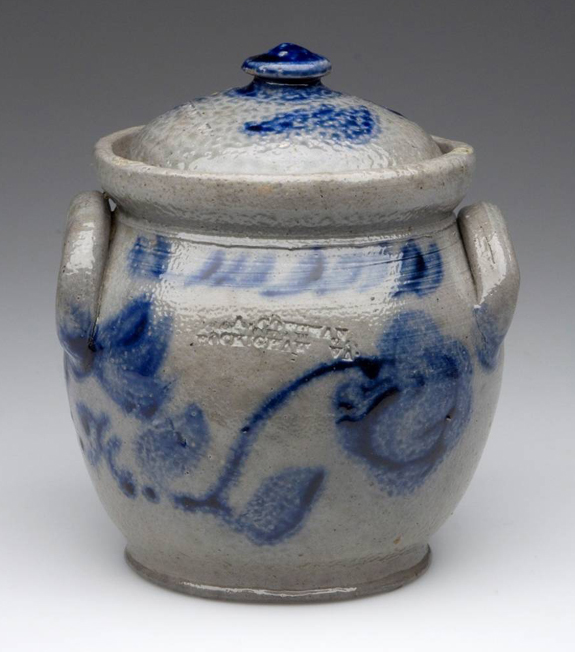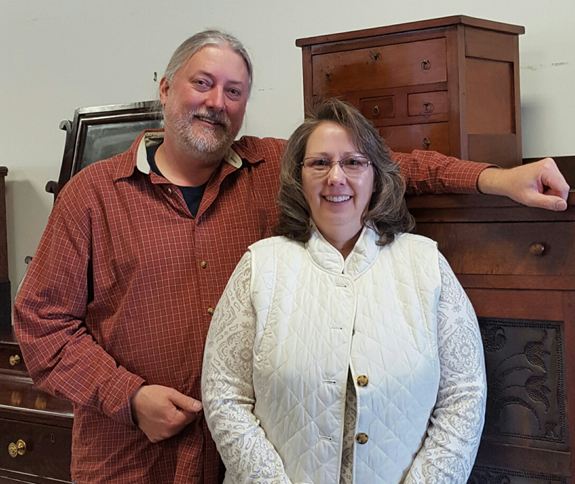Jeff and Beverley Evans are principals at Jeffrey S. Evans & Associates, the auctions and appraisals firm they founded in Mount Crawford, Va., in 2009. Noted scholars of the region’s decorative arts, they share a deep interest in the people and history of their native Shenandoah Valley. After meeting in high school and marrying in 1981, the couple, who have one son, worked for Green Valley Auctions, founded by Jeff’s parents in 1967. Jeffrey S. Evans & Associates conducts roughly a dozen auctions a year and is well known for its cataloged sales of Americana, ceramics and glass. Husband and wife serve on the boards of assorted museums and historical organizations and are outstanding cooks and gracious hosts. Their restoration of their historic farmhouse in Broadway, Va., won state and national praise.
Jeff, can you tell us about your scholarly projects?
My first museum project was in 2004. I served as guest curator and co-wrote the catalog for “A Great Deal of Stone & Earthen Ware, The Rockingham Co. School of Folk Pottery” at the Shenandoah Valley Folk Art & Heritage Center in Dayton, Va. I presented “Shenandoah Valley of Virginia Seating Forms of the Late Eighteenth to Early Twentieth Century” at MESDA’S 2009 Furniture Seminar and served as guest curator for “Come In and Have a Seat: Vernacular Chairs of the Shenandoah Valley” at the Museum of the Shenandoah Valley in Winchester, Va. I had collected about 500 chairs since the 1970s. I always tagged them when I bought them with whatever information I had, so I had a good starting point for the lecture and exhibition. In conjunction with that exhibit, we had a chair identification day and invited folks to bring in chairs of their own. We told them as much as we could about their chairs. I wrote the catalog for that exhibit, too.
What else?
I’ve done a number of exhibitions and lectures at the Museum of the Shenandoah Valley, Colonial Williamsburg and the Museum of Early Southern Decorative Arts on the decorative arts of the region. The most recent, in 2014, was “Safes of The Shenandoah Valley,” about punched-tin paneled food safes, at the MSV. A book based on the exhibit will be published later this year. I’m on MESDA’s advisory board. We recently spearheaded the renovation of their Shenandoah Valley gallery.

Jeff’s favorite piece is this salt-glazed stoneware sugar bowl stamped “A. COFFMAN / ROCKIGHAM [sic] VA.” for Rockingham Co. potter Andrew Coffman (1795–1853). Decoration signed in cobalt “J H” for potter John D. Heatwole (1826–1907), who married Coffman’s daughter Elizabeth.
Beverley, aren’t you a textiles maven?
I’m a member of the American Quilt Study Guild. Jeff and I organized “Counterpanes and White Work of the Shenandoah Valley,” including textiles from our collection, at the Virginia Quilt Museum. We enjoyed doing that one together. Jeff wrote the exhibit catalog. We’re planning our first dedicated textiles and sewing auction for July 16. So far, we have material deaccessioned by MESDA, quilts from Virginia and Maryland, coverlets, other bedcovers, samplers, vintage clothing, sewing tools and accessories. The MESDA textiles we’re selling are duplicates or outside of their collecting area.
What do you collect? Does it conflict with your business?
We collect early American glass as well as folk pottery, textiles and other Shenandoah Valley material. It has never been a problem. People know about our interests and they know we’ve used our collections for exhibits and lectures. We’re very open about it and folks know that we have a serious interest in researching. We’re always willing to share the collections and what we know about them. And we buy very little at auctions, so we’re not competing with our customers.
What are your most memorable sales?
We’re probably best known for selling what is arguably the most important piece of paint decorated American furniture to come to auction, a Shenandoah Valley hanging wall cupboard made about 1800 by Johannes Spitler for the Strickler family. It is decorated with a leaping stag and had remained in the family since 1840. It brought a record $965,000 in 2004 and is now in the Jane Katcher collection. The John and Lil Palmer Americana collection was a landmark single-owner sale in 2014. In May 2017, we’ll be selling the Sandwich glass collection of Joan Kaiser, the author and expert.
What’s best about what you do?
Being born and raised in the Shenandoah Valley, we have a special connection with and understanding of its material culture. We really care about the history of the objects we handle. We research diligently and we share whatever we learn. It has worked very well for us.
—Rick Russack


